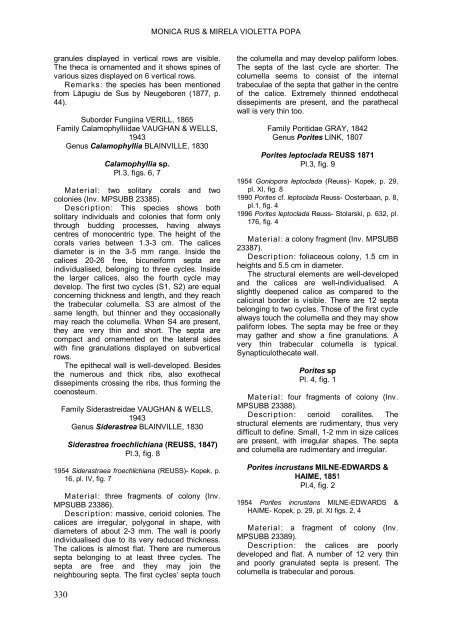taxonomic notes on the badenian corals from lăpugiu de sus
taxonomic notes on the badenian corals from lăpugiu de sus
taxonomic notes on the badenian corals from lăpugiu de sus
Create successful ePaper yourself
Turn your PDF publications into a flip-book with our unique Google optimized e-Paper software.
MONICA RUS & MIRELA VIOLETTA POPA<br />
granules displayed in vertical rows are visible.<br />
The <strong>the</strong>ca is ornamented and it shows spines of<br />
various sizes displayed <strong>on</strong> 6 vertical rows.<br />
Remarks: <strong>the</strong> species has been menti<strong>on</strong>ed<br />
<strong>from</strong> Lăpugiu <strong>de</strong> Sus by Neugeboren (1877, p.<br />
44).<br />
Subor<strong>de</strong>r Fungiina VERILL, 1865<br />
Family Calamophylliidae VAUGHAN & WELLS,<br />
1943<br />
Genus Calamophyllia BLAINVILLE, 1830<br />
Calamophyllia sp.<br />
Pl.3, figs. 6, 7<br />
Material: two solitary <strong>corals</strong> and two<br />
col<strong>on</strong>ies (Inv. MPSUBB 23385).<br />
Descripti<strong>on</strong>: This species shows both<br />
solitary individuals and col<strong>on</strong>ies that form <strong>on</strong>ly<br />
through budding processes, having always<br />
centres of m<strong>on</strong>ocentric type. The height of <strong>the</strong><br />
<strong>corals</strong> varies between 1.3-3 cm. The calices<br />
diameter is in <strong>the</strong> 3-5 mm range. Insi<strong>de</strong> <strong>the</strong><br />
calices 20-26 free, bicuneiform septa are<br />
individualised, bel<strong>on</strong>ging to three cycles. Insi<strong>de</strong><br />
<strong>the</strong> larger calices, also <strong>the</strong> fourth cycle may<br />
<strong>de</strong>velop. The first two cycles (S1, S2) are equal<br />
c<strong>on</strong>cerning thickness and length, and <strong>the</strong>y reach<br />
<strong>the</strong> trabecular columella. S3 are almost of <strong>the</strong><br />
same length, but thinner and <strong>the</strong>y occasi<strong>on</strong>ally<br />
may reach <strong>the</strong> columella. When S4 are present,<br />
<strong>the</strong>y are very thin and short. The septa are<br />
compact and ornamented <strong>on</strong> <strong>the</strong> lateral si<strong>de</strong>s<br />
with fine granulati<strong>on</strong>s displayed <strong>on</strong> subvertical<br />
rows.<br />
The epi<strong>the</strong>cal wall is well-<strong>de</strong>veloped. Besi<strong>de</strong>s<br />
<strong>the</strong> numerous and thick ribs, also exo<strong>the</strong>cal<br />
dissepiments crossing <strong>the</strong> ribs, thus forming <strong>the</strong><br />
coenosteum.<br />
Family Si<strong>de</strong>rastreidae VAUGHAN & WELLS,<br />
1943<br />
Genus Si<strong>de</strong>rastrea BLAINVILLE, 1830<br />
Si<strong>de</strong>rastrea froechlichiana (REUSS, 1847)<br />
Pl.3, fig. 8<br />
1954 Si<strong>de</strong>rastraea froechlichiana (REUSS)- Kopek, p.<br />
16, pl. IV, fig. 7<br />
Material: three fragments of col<strong>on</strong>y (Inv.<br />
MPSUBB 23386).<br />
Descripti<strong>on</strong>: massive, cerioid col<strong>on</strong>ies. The<br />
calices are irregular, polyg<strong>on</strong>al in shape, with<br />
diameters of about 2-3 mm. The wall is poorly<br />
individualised due to its very reduced thickness.<br />
The calices is almost flat. There are numerous<br />
septa bel<strong>on</strong>ging to at least three cycles. The<br />
septa are free and <strong>the</strong>y may join <strong>the</strong><br />
neighbouring septa. The first cycles’ septa touch<br />
<strong>the</strong> columella and may <strong>de</strong>velop paliform lobes.<br />
The septa of <strong>the</strong> last cycle are shorter. The<br />
columella seems to c<strong>on</strong>sist of <strong>the</strong> internal<br />
trabeculae of <strong>the</strong> septa that ga<strong>the</strong>r in <strong>the</strong> centre<br />
of <strong>the</strong> calice. Extremely thinned endo<strong>the</strong>cal<br />
dissepiments are present, and <strong>the</strong> para<strong>the</strong>cal<br />
wall is very thin too.<br />
Family Poritidae GRAY, 1842<br />
Genus Porites LINK, 1807<br />
Porites leptoclada REUSS 1871<br />
Pl.3, fig. 9<br />
1954 G<strong>on</strong>iopora leptoclada (Reuss)- Kopek, p. 29,<br />
pl. XI, fig. 8<br />
1990 Porites cf. leptoclada Reuss- Oosterbaan, p. 8,<br />
pl.1, fig. 4<br />
1996 Porites leptoclada Reuss- Stolarski, p. 632, pl.<br />
176, fig. 4<br />
Material: a col<strong>on</strong>y fragment (Inv. MPSUBB<br />
23387).<br />
Descripti<strong>on</strong>: foliaceous col<strong>on</strong>y, 1.5 cm in<br />
heights and 5.5 cm in diameter.<br />
The structural elements are well-<strong>de</strong>veloped<br />
and <strong>the</strong> calices are well-individualised. A<br />
slightly <strong>de</strong>epened calice as compared to <strong>the</strong><br />
calicinal bor<strong>de</strong>r is visible. There are 12 septa<br />
bel<strong>on</strong>ging to two cycles. Those of <strong>the</strong> first cycle<br />
always touch <strong>the</strong> columella and <strong>the</strong>y may show<br />
paliform lobes. The septa may be free or <strong>the</strong>y<br />
may ga<strong>the</strong>r and show a fine granulati<strong>on</strong>s. A<br />
very thin trabecular columella is typical.<br />
Synapticulo<strong>the</strong>cate wall.<br />
Porites sp<br />
Pl. 4, fig. 1<br />
Material: four fragments of col<strong>on</strong>y (Inv.<br />
MPSUBB 23388).<br />
Descripti<strong>on</strong>: cerioid corallites. The<br />
structural elements are rudimentary, thus very<br />
difficult to <strong>de</strong>fine. Small, 1-2 mm in size calices<br />
are present, with irregular shapes. The septa<br />
and columella are rudimentary and irregular.<br />
Porites incrustans MILNE-EDWARDS &<br />
HAIME, 1851<br />
Pl.4, fig. 2<br />
1954 Porites incrustans MILNE-EDWARDS &<br />
HAIME- Kopek, p. 29, pl. XI figs. 2, 4<br />
Material: a fragment of col<strong>on</strong>y (Inv.<br />
MPSUBB 23389).<br />
Descripti<strong>on</strong>: <strong>the</strong> calices are poorly<br />
<strong>de</strong>veloped and flat. A number of 12 very thin<br />
and poorly granulated septa is present. The<br />
columella is trabecular and porous.<br />
330

















